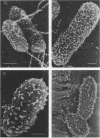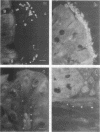Abstract
Normal bacteria can translocate (migrate) across an intact intestinal mucosa, but the anatomical site of bacterial translocation has not been defined. Gastrointestinal (GI) cross-sections were obtained from mice monoassociated with high cecal concentrations of Escherichia coli, Proteus mirabilis, or Enterococcus faecalis. As previously reported (C. L. Wells, R. P. Jechorek, and K. J. Gillingham, Arch. Surg. 126:247-252, 1991), these mice had viable translocating bacteria recovered from mesenteric lymph nodes and livers. No abnormal GI histology was noted. Immunofluorescence was used to localize GI bacteria, and similar observations were made with each of the three bacterial species. Smaller numbers (P less than 0.01) of bacteria were observed in stomach and small intestinal tissues than in cecal and colonic tissues, suggesting that the preferred site of tissue penetration for intestinal E. coli, P. mirabilis, and E. faecalis might be the cecum or colon as opposed to the stomach or small intestine.
Full text
PDF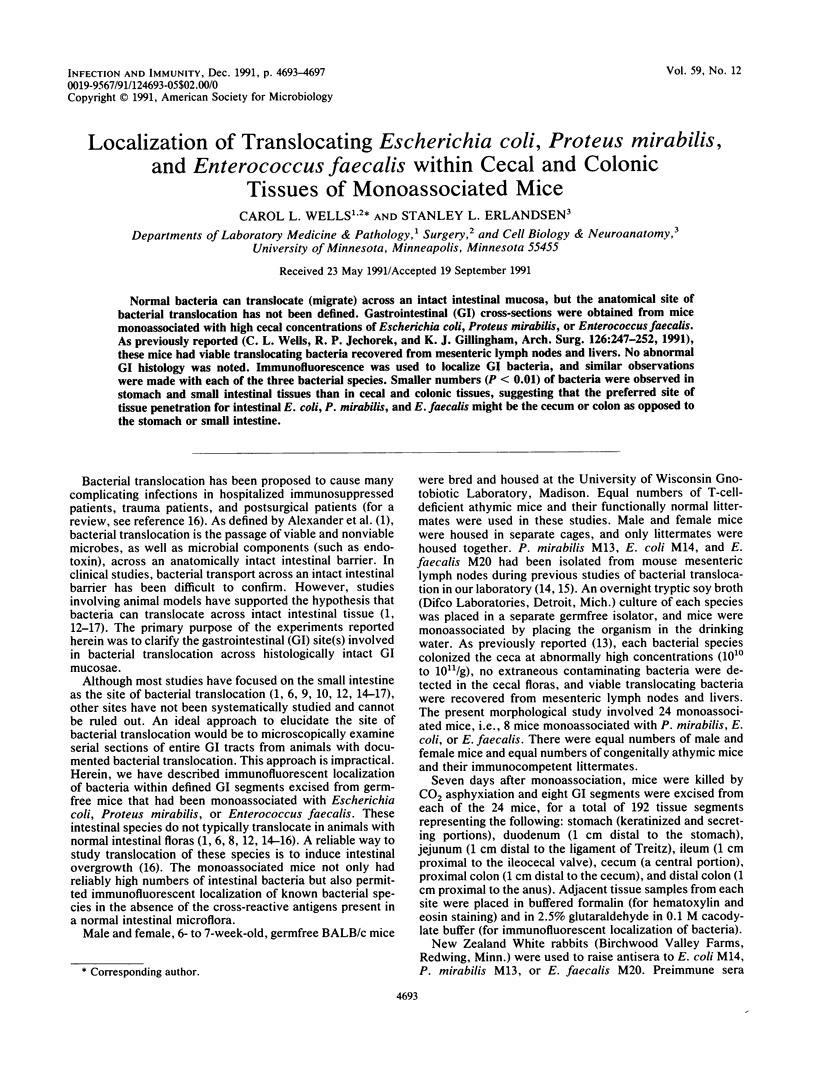
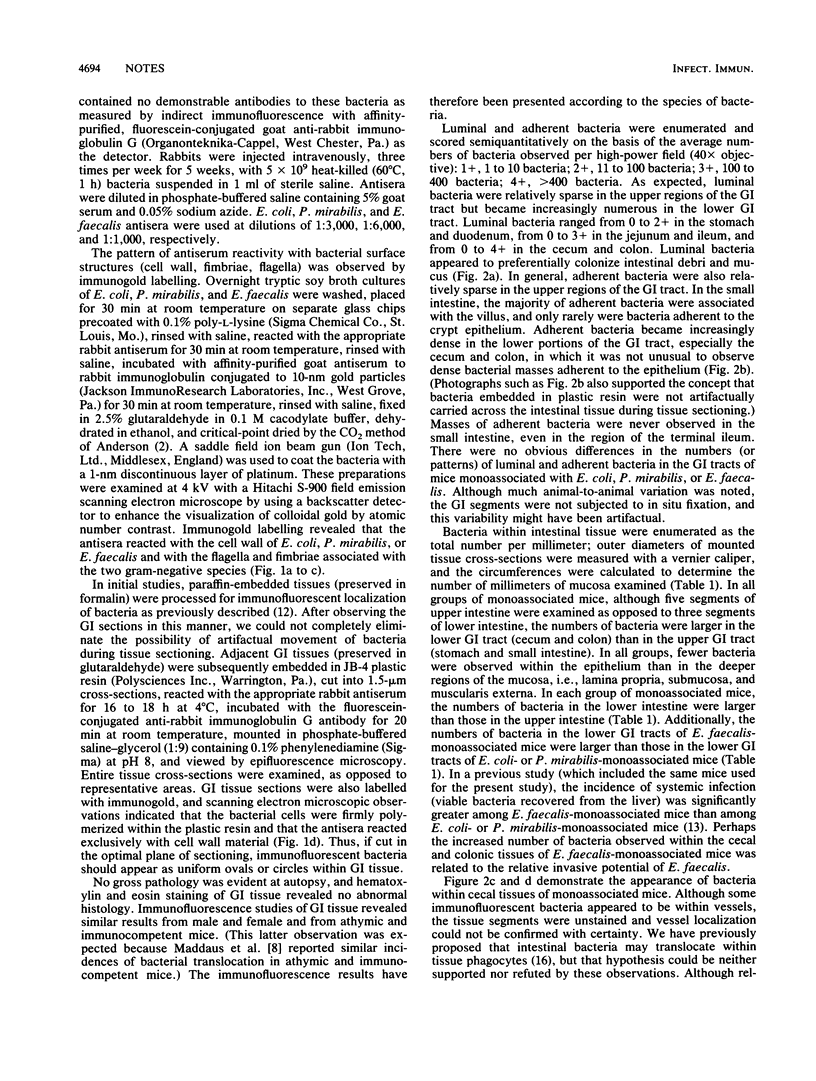
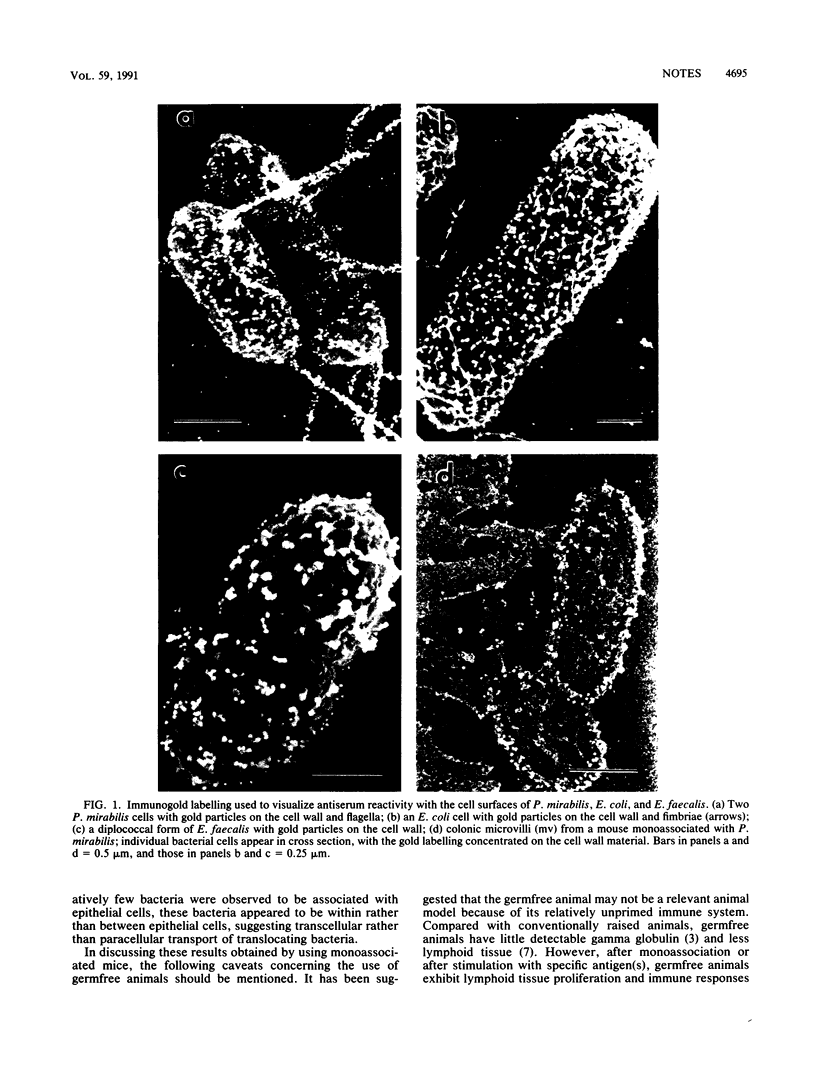
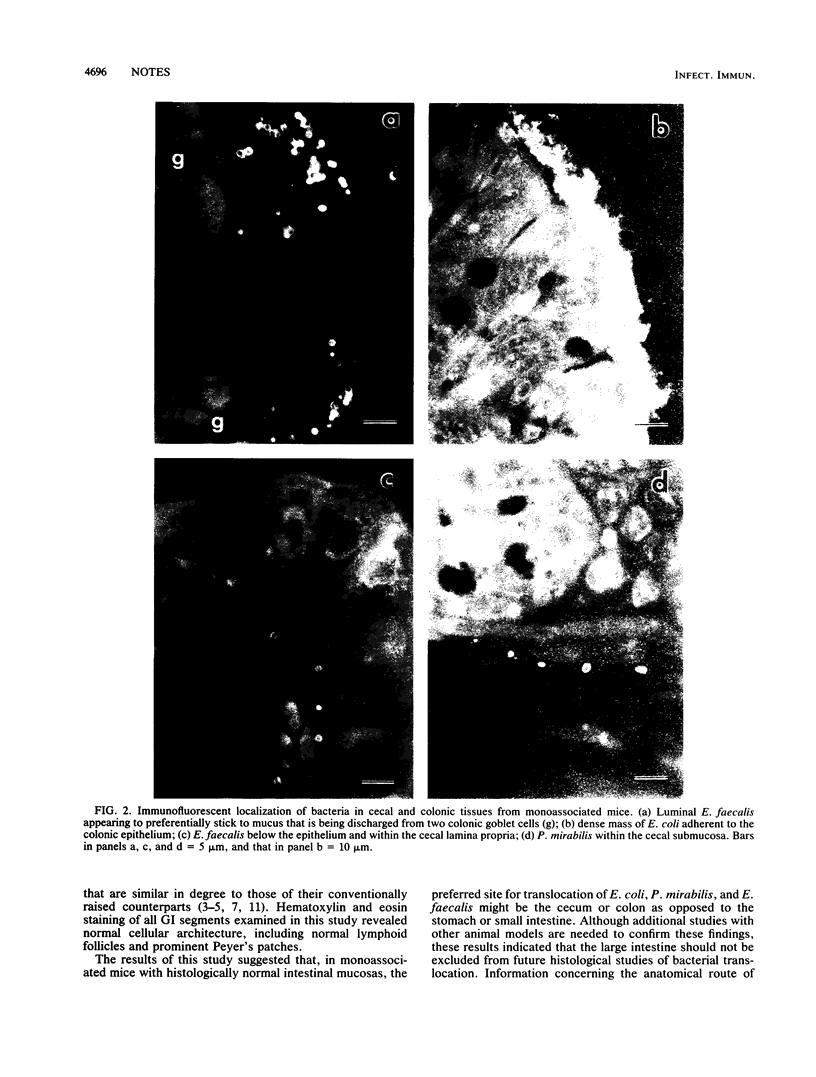
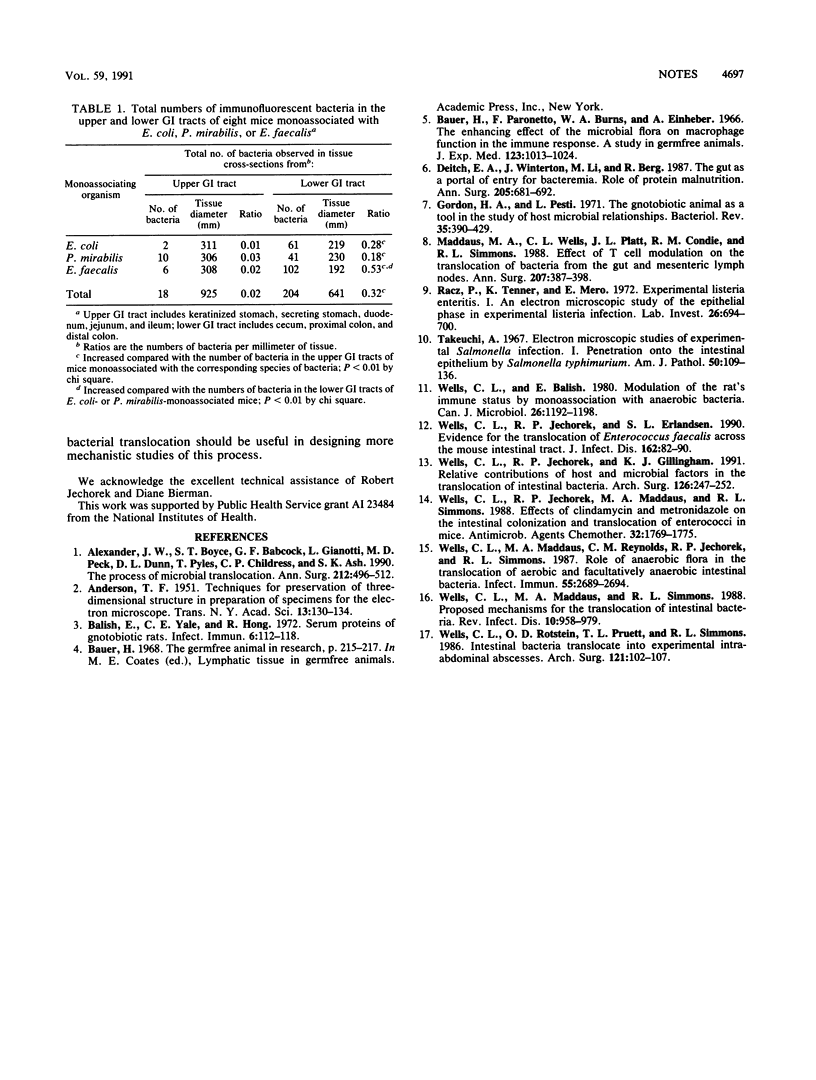
Images in this article
Selected References
These references are in PubMed. This may not be the complete list of references from this article.
- Alexander J. W., Boyce S. T., Babcock G. F., Gianotti L., Peck M. D., Dunn D. L., Pyles T., Childress C. P., Ash S. K. The process of microbial translocation. Ann Surg. 1990 Oct;212(4):496–512. doi: 10.1097/00000658-199010000-00012. [DOI] [PMC free article] [PubMed] [Google Scholar]
- Balish E., Yale C. E., Hong R. Serum proteins of gnotobiotic rats. Infect Immun. 1972 Aug;6(2):112–118. doi: 10.1128/iai.6.2.112-118.1972. [DOI] [PMC free article] [PubMed] [Google Scholar]
- Bauer H., Paronetto F., Burns W. A., Einheber A. The enhancing effect of the microbial flora on macrophage function and the immune response. A study in germfree mice. J Exp Med. 1966 Jun 1;123(6):1013–1024. doi: 10.1084/jem.123.6.1013. [DOI] [PMC free article] [PubMed] [Google Scholar]
- Deitch E. A., Winterton J., Li M., Berg R. The gut as a portal of entry for bacteremia. Role of protein malnutrition. Ann Surg. 1987 Jun;205(6):681–692. doi: 10.1097/00000658-198706000-00010. [DOI] [PMC free article] [PubMed] [Google Scholar]
- Gordon H. A., Pesti L. The gnotobiotic animal as a tool in the study of host microbial relationships. Bacteriol Rev. 1971 Dec;35(4):390–429. doi: 10.1128/br.35.4.390-429.1971. [DOI] [PMC free article] [PubMed] [Google Scholar]
- Maddaus M. A., Wells C. L., Platt J. L., Condie R. M., Simmons R. L. Effect of T cell modulation on the translocation of bacteria from the gut and mesenteric lymph node. Ann Surg. 1988 Apr;207(4):387–398. doi: 10.1097/00000658-198804000-00004. [DOI] [PMC free article] [PubMed] [Google Scholar]
- Rácz P., Tenner K., Mérö E. Experimental Listeria enteritis. I. An electron microscopic study of the epithelial phase in experimental listeria infection. Lab Invest. 1972 Jun;26(6):694–700. [PubMed] [Google Scholar]
- Takeuchi A. Electron microscope studies of experimental Salmonella infection. I. Penetration into the intestinal epithelium by Salmonella typhimurium. Am J Pathol. 1967 Jan;50(1):109–136. [PMC free article] [PubMed] [Google Scholar]
- Wells C. L., Balish E. Modulation of the rats' immune status by monoassociation with anaerobic bacteria. Can J Microbiol. 1980 Oct;26(10):1192–1198. doi: 10.1139/m80-199. [DOI] [PubMed] [Google Scholar]
- Wells C. L., Jechorek R. P., Erlandsen S. L. Evidence for the translocation of Enterococcus faecalis across the mouse intestinal tract. J Infect Dis. 1990 Jul;162(1):82–90. doi: 10.1093/infdis/162.1.82. [DOI] [PubMed] [Google Scholar]
- Wells C. L., Jechorek R. P., Gillingham K. J. Relative contributions of host and microbial factors in bacterial translocation. Arch Surg. 1991 Feb;126(2):247–252. doi: 10.1001/archsurg.1991.01410260137020. [DOI] [PubMed] [Google Scholar]
- Wells C. L., Jechorek R. P., Maddaus M. A., Simmons R. L. Effects of clindamycin and metronidazole on the intestinal colonization and translocation of enterococci in mice. Antimicrob Agents Chemother. 1988 Dec;32(12):1769–1775. doi: 10.1128/aac.32.12.1769. [DOI] [PMC free article] [PubMed] [Google Scholar]
- Wells C. L., Maddaus M. A., Reynolds C. M., Jechorek R. P., Simmons R. L. Role of anaerobic flora in the translocation of aerobic and facultatively anaerobic intestinal bacteria. Infect Immun. 1987 Nov;55(11):2689–2694. doi: 10.1128/iai.55.11.2689-2694.1987. [DOI] [PMC free article] [PubMed] [Google Scholar]
- Wells C. L., Maddaus M. A., Simmons R. L. Proposed mechanisms for the translocation of intestinal bacteria. Rev Infect Dis. 1988 Sep-Oct;10(5):958–979. doi: 10.1093/clinids/10.5.958. [DOI] [PubMed] [Google Scholar]
- Wells C. L., Rotstein O. D., Pruett T. L., Simmons R. L. Intestinal bacteria translocate into experimental intra-abdominal abscesses. Arch Surg. 1986 Jan;121(1):102–107. doi: 10.1001/archsurg.1986.01400010116016. [DOI] [PubMed] [Google Scholar]



